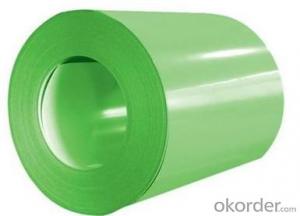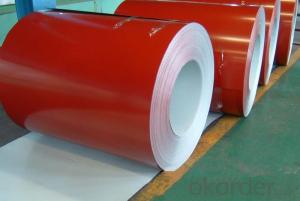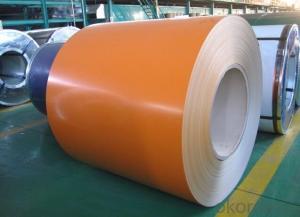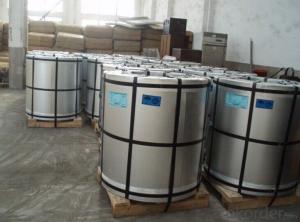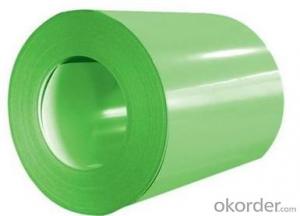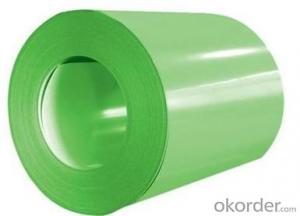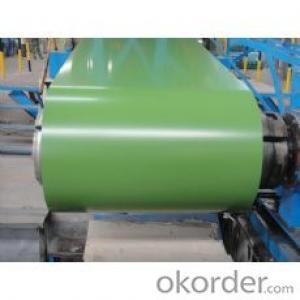Pre-painted Galvanized/Aluzinc Steel Sheet Coil with Prime Quality and Lowest Price Color Green
- Loading Port:
- Shanghai
- Payment Terms:
- TT OR LC
- Min Order Qty:
- 100 m.t.
- Supply Capability:
- 10000 m.t./month
OKorder Service Pledge
OKorder Financial Service
You Might Also Like
1.Pre-Painted Galvanized/Aluzinc Steel Coil Description:
Pre-painted Galvanized/Aluzinc Steel Coil with GI or Aluzinc as base metal, then after fring and cooling ,finally become pre-painted galvanized/aluzinc steel with good capable of decoration,molding,corrosion resistance,superior workability,durability and weather resistance.
2.Main Features of the Pre-Painted Galvanized/Aluzinc Steel Coil
• High manufacturing accuracy
• Good capable of decoration
• Superior workability
• Good visual effect
3.Detail Images of Pre-Painted Galvanized Steel Coil
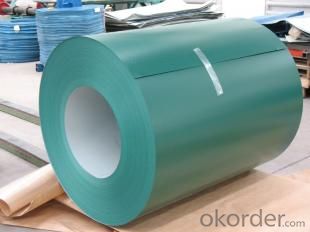
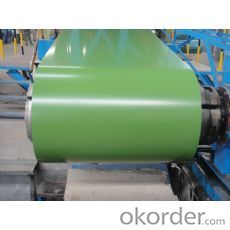
4.Quick Details of the Pre-Painted Galvanized/Aluzinc Steel Coil
Standard | ASTM ,EN,JIS | Grade: | CS,DX51D+Z,CGCC | Thickness | 0.16mm-1.5mm |
Place of Origin | China(Mainland) | Brand Name | Type | Steel Coil | |
Technique | Galvanized/Aluzinc | Surface | Coated | Application | Roof panel |
Width | 900mm-1250mm | Length | Coils | Zinc Coating | 30g/m2-275g/m2 |
5.FAQ
4. How long can we receive the product after purchase?
Usually within thirty working days after receiving buyer’s advance payment or LC. We will arrange the factory manufacturing as soon as possible. The cargo readiness usually takes 15-25 days, but the shipment will depend on the vessel situation.
1. What’s the application of this product?
Roof, roof structure, surface sheet of balcony, frame of window, etc.
2. What’s the brand of the paint?
We use the best brand of all of the word—AKZO.
- Q: How are steel coils used in the manufacturing of automotive hoods?
- Steel coils are used in the manufacturing of automotive hoods as they are shaped and formed into the desired hood design. These coils are processed through various stages such as cutting, stamping, and welding to create the hood's structure. The strength and durability of steel make it an ideal material for automotive hoods, ensuring they can withstand impacts and provide protection to the engine compartment.
- Q: When and where did soldiers wearing steel protective helmets start ?It seems to have been common by the start of WW1
- They used to wear entire steel suits of armor in the middle ages. They stopped wearing the armor with the invention of reliable firearms, but steel helmets have been around since then. Before that, they wore iron or bronze helmets. Some armies went to a soft cap through the mid 1800s until fragmentary type artillery rounds appeared. Then helmets started coming back again. WWI was the big return.
- Q: How are steel coils used in the production of metal partitions?
- Steel coils are an essential component in the production of metal partitions. These coils are typically made from high-quality steel and serve as the raw material for manufacturing the partitions. Firstly, the steel coils undergo a process called slitting, where they are cut into narrower strips of the desired width. This enables manufacturers to customize the size of the metal partitions according to specific project requirements. After slitting, the steel strips are then fed into a roll forming machine. This machine gradually shapes the strips into the desired profile for the metal partitions. The roll forming process involves passing the steel strips through a series of rollers, which progressively bend and form the metal into the desired shape and dimensions. Once the metal has been formed into the desired shape, it is cut into appropriate lengths to create individual partitions. These partitions are then further processed, such as through welding or spot welding, to join different components together and enhance their structural integrity. Steel coils are preferred for metal partition production due to their strength, durability, and versatility. The use of steel ensures that the partitions can withstand heavy loads, resist corrosion, and provide long-lasting performance. Additionally, steel coils offer a high degree of design flexibility, allowing for the creation of various partition styles, such as solid panels, perforated screens, or mesh partitions. Overall, steel coils play a crucial role in the production of metal partitions by providing the necessary raw material, strength, and customization options required for these versatile architectural elements.
- Q: How are steel coils used in the production of scaffolding?
- Scaffolding production heavily relies on steel coils as they serve as the primary raw material for manufacturing various components of scaffolding systems. These coils, typically composed of high-quality steel, are processed through cutting, shaping, and welding operations to obtain the desired dimensions and shapes for scaffolding components, including vertical and horizontal tubes, diagonal braces, and base plates. The main structural elements of scaffolding are the tubes and pipes formed from steel coils. These elements are responsible for constructing the framework of the scaffolding, comprising vertical uprights or standards, horizontal ledgers, and transoms that connect them. By providing strength, stability, and load-bearing capacity, these components ensure the safety of workers operating at elevated heights. Furthermore, diagonal braces, an essential part of scaffolding, are manufactured from steel coils. These braces are strategically installed diagonally between the vertical standards to reinforce the scaffolding structure, adding extra support and stability to prevent swaying or collapsing. Another crucial component produced from steel coils is the base plate. These plates serve as the foundation for the scaffolding structure, offering a solid and stable base to evenly distribute weight and load. Typically positioned at the bottom of each vertical standard, they play a vital role in maintaining stability and preventing sinking or sliding. To summarize, steel coils play a fundamental role in scaffolding production. Through their transformation into tubes, pipes, braces, and base plates, they form the framework and provide the necessary strength, stability, and load-bearing capacity for safe and efficient scaffolding systems.
- Q: i know stainless steel swords are decoration, what metal is ok for a sword that is usable
- Why the interest in a 'usable' sword ~~ are you really going to use it?
- Q: How do steel coils contribute to the marine industry?
- Steel coils contribute to the marine industry by being used in the construction of ships and offshore structures. They are essential for manufacturing various components, such as hulls, decks, beams, and structural supports. Steel coils provide strength, durability, and corrosion resistance, ensuring the longevity and safety of marine vessels and infrastructure. Additionally, steel coils are used for the production of marine equipment, including cranes, winches, and anchor chains, further enhancing the efficiency and functionality of the marine industry.
- Q: I know that mild steel is more brittle than cast iron....but that is all.......please help??Thank you in advance......Ruby:D
- This Site Might Help You. RE: what is the diiferent in composition between mild steel and cast iron? I know that mild steel is more brittle than cast iron....but that is all.......please help? Thank you in advance......Ruby :D
- Q: would you consider steel a flexible substance...i am debating this with my coworkers.Thanks,
- Yes, looking at it from an engineering standpoint. Depending on it's shape it can be used for many applications where flexibility is important. Steel springs for example, or guitar strings. Whenever you're debating these kinds of matters, it is important to keep in mind that the use of a material depends on the shape, the size and the weight it's going to be used in. A big block of steel will be used in a different manner as a piece of steel wire.
- Q: Hey I just got a mini 14 manufactured in 1980. I also had some .223 Wolf steel cased HP rounds (about 200) that i could shoot throught it, but I was just wondering if its a bad idea to use this steel cased ammo...? Only the casing is steel i believe... and the bullet is copper jacketedthanks for your help
- Wolf's steel cased ammo isn't bad as practice/plinking ammo, especially for the price, as long as you give your weapons MULTIPLE, THOROUGH cleanings between uses, to be sure and remove ALL the gas fouling left by the Wolf components. HOWEVER.................. As Wolf steel cases are lacquer coated, DO NOT leave a round in a hot chamber, even during short pauses between stages of fire on the range, as the lacquer coating WILL melt, and cause the round to seize in the chamber, causing extraction and jamming problems, especially if the weapon is allowed to cool down with the round left in the chamber. Be extra diligent in removing this lacquer fouling when cleaning the weapon later. I have personally seen other shooters have the case rims ripped off spent cases in the chambers, causing a trip to the gunsmith to have the stuck case removed without damaging the weapon's chamber and actioin, at no minor expense.
- Q: can u use stainless steel to make a coin? why or why not? answers based on facts plz.
- Stainless steel has been used by some countries to make coins, but it's not an ideal metal. When a coin is struck, a die comes down and strikes the blank with many tons of force (the blank is also sitting on top of another die--one has the image on the obverse (front) of the coin, while the other die has the image of the reverse of the coin). When the die strikes the blank, the force causes the metal in the blank to flow into the recesses of the die. The problem with stainless steel is that it doesn't want to flow into the die. To get an image, either the relief (how high the raised portion of the design will be) has to be very low, and the coin has to have a simple design, or they have to greatly increase the pressure of the strike. This slows the coining press down, and greatly shortens the life of the dies.
Send your message to us
Pre-painted Galvanized/Aluzinc Steel Sheet Coil with Prime Quality and Lowest Price Color Green
- Loading Port:
- Shanghai
- Payment Terms:
- TT OR LC
- Min Order Qty:
- 100 m.t.
- Supply Capability:
- 10000 m.t./month
OKorder Service Pledge
OKorder Financial Service
Similar products
Hot products
Hot Searches
Related keywords
